Cooking in an unfamiliar kitchen is always a bit of an adventure. You never know what you’re going to find, what “obvious essentials” will be glaringly absent, what will need to be improvised, and whether you’ll rise to the occasion.
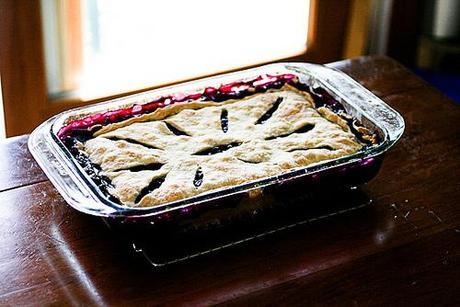
Last week, our family all rented a house together in Cape Cod. And I should say extended family–not just us three sisters and our parents but various generations of in-laws and of course my two sons to lap up all the attention. While we made sure to eat plenty of fried seafood, ice cream, and pizza, we also made use of the kitchen, which came fully stocked with all sorts of pantry items of varying age (how old exactly were the three 16 ounce jars of ground nutmeg?) and provenance. And because the rule of the house was that anything you use up has to be replaced by the end of your stay, lots of boxes were nearly–but not quite–emptied. It’s always the technicalities isn’t it?
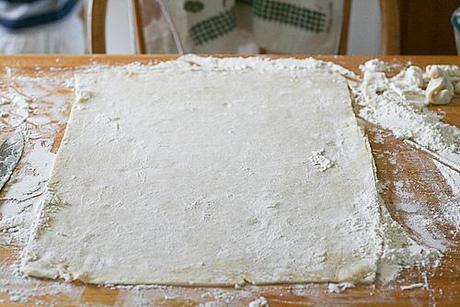
Since we had a full house, though, we were going to the grocery store seemingly every day. And with so many people to feed, in summer, I decided I had to make a pie. But here’s that part about the trickiness of baking in someone else’s kitchen. There was no pie plate to be found. Nor a rolling pin. And I hardly have to tell you that lacking those two items, there was no pastry cutter.
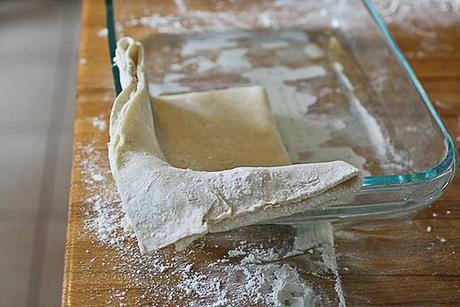
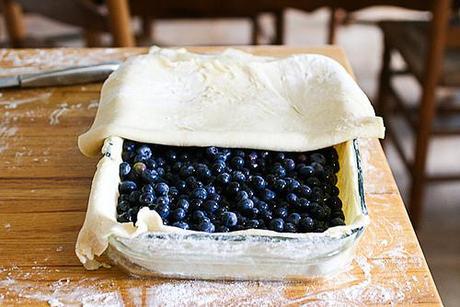
But this is a happy tale of staring down hardships and succeeding, not a mournful tale of a dessert that never came to be. After all, adversity is the mother of invention.
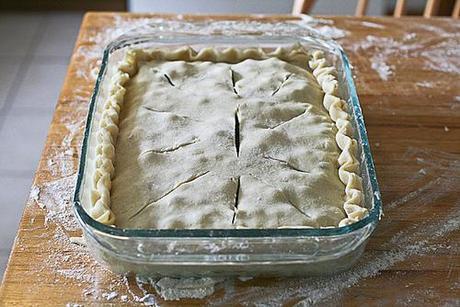
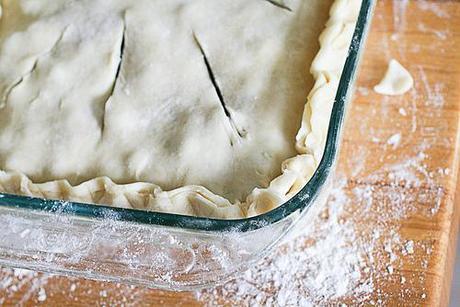
As for the first obstacle–the missing vessel–a 9 X 13 casserole dish proved to be more than a perfect substitute. More than perfect since its roomier size meant more pie for all–hardly a tragedy. I used 1 1/2 times my normal pie dough recipe which yielded a generous amount of crust. And that dough was made by the most low-tech method of all, simply rubbing the butter into the flour: a technique I have a newfound confidence in, thanks to this video.

Finally, the best kitchen hack, and one which proves that good wine always saves the day. A wine bottle (we had a few in the fridge) made a fine stand-in for a rolling pin, with its naturally cool surface, heft, and smooth cylindrical shape. It was easy to maneuver, despite its missing “handle” on one end, and while I feared sloshing alcohol would be distracting to my work, a full bottle turned out to glide right along the surface. The label left a slight indentation in the rolled-out dough, but for me the additional evidence of my weapon of choice was charming rather than frustrating. I wouldn’t, however, recommend using a fine vintage for this, if you’re one of those people who saves the labels in a wine diary–things got a bit messy. All in all, I was pretty excited about this whole process. I’ll be using a rolling pin when available but freely admit that I’ll be patting myself on the back about this one for a while. Who cares if I can’t claim to have invented the idea? Note that I’ve added extra tips on the rolling out process–applicable to whatever tool you’re using–in the recipe itself.
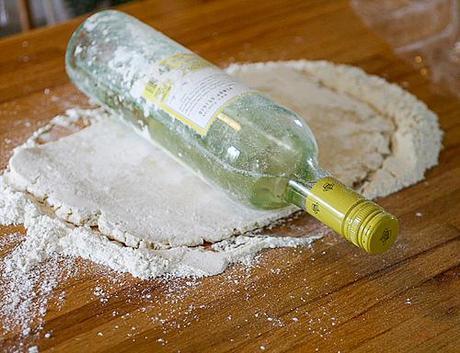
I subbed in limes for lemons, as I like to do–its zing pairs nicely with blueberries, and we had plenty on hand for gin and tonics anyway. Brown sugar had been purchased for cookies and was used instead of the pantry’s remaining scrapings of white sugar. After all, we wouldn’t want to have to replace it now, would we?
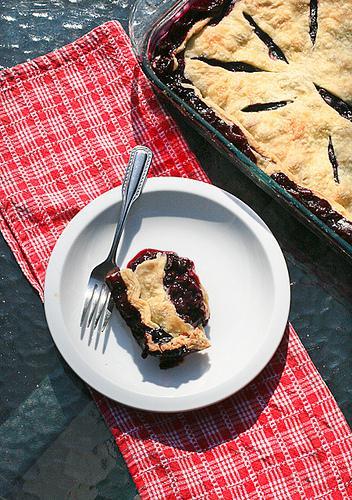
Bright afternoon sun, sea air only steps away and fresh blueberry pie passed around a large table. And a bit of adventure (broadly defined). Can’t get more summer than that.
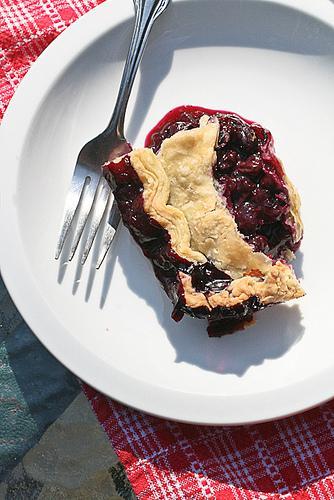
Vacation Blueberry Pie
Note: These measurements are for a 9 X 13 casserole dish. If you’re in a more fully stocked kitchen and want to use a regular pie plate, use 6 cups of blueberries, and reduce the sugar (so long as you want to keep it on the less sweet side, as I do).
Pie Crust- 3 3/4c flour
- 4 1/2 t sugar
- 1 1/2 t salt
- 3 sticks (12 ounces, or 1 1/2 cups) very cold unsalted butter, cut into 1/2″ pieces
- 3/4 to 1c ice cold water (put a cup of the coldest water you have in the fridge with ice in it for at least 15 minutes).
Pie Filling
- 8c blueberries (4 pint packages)
- 2/3 c brown sugar
- 1/4c corn starch
- 1 lime (zest and juice)
Note that there is chilling time in this recipe, so make sure to factor this into your plans. This need not be a nuisance–you can make the crust a day (or a few) ahead so that you need only roll it out, fill it, and bake it the day you want to serve it.
Make the pie crust. Stir the flour, salt, and sugar together. Cut the cold butter into the flour mixture until it is pebbly with pea size chunks, and clumps together when you grasp it. (See my post here for full instructions, or alternately rub the butter into the flour as I described earlier in this post). Dribble in the cold water and stir with a spatula until it forms a rough ball. Only add as much water as is necessary to form the ball–it may be less than the recipe calls for and will depend on the humidity in your kitchen.
Dump onto a clean surface and flatten the dough into a rough square. Cut it in half, with one half slightly larger than the other. (This happens to me without even trying, of course!) Wrap in plastic and chill for at least an hour.
Take the larger piece of dough out of the refrigerator and unwrap. Place on a well-floured surface, then flip it over. This is easier than flouring your rolling pin, though technically it’s better to flour the pin. I like to make fingerprint indentations around the perimiter of the dough to help soften the edges–this seems to help prevent cracking. Note that although the name of the game in pastry is cold, cold, cold, I do find that if the dough is TOO cold it’s almost impossible to roll–though no one ever seems to admit this. You can whack it a bit with your rolling pin to soften it or just give it a few minutes to soften slightly on its own before proceeding.
Roll the dough out into a large rectangle. Trim it so that it measures 13 inches by 17 inches. Fold in half, and then in half again, and transfer to the casserole dish. Chill for a half hour.
In the meantime, make the filling–stir together the berries, sugar, cornstarch, zest, and juice and set aside. Preheat the oven to 425F.
Remove the second piece of dough from the refrigerator, and roll into a rectangle trimmed to measure about 11 inches by 15 inches. Remove the casserole dish from the refrigerator, fill with the berries, and transfer the second piece of dough on top. Pat it down gently over the filling, and crimp the edges together with the lower layer of crust. (Crimp with your fingers by holding your thumb and pointer finger together on one side of the joined pieces of dough, while using your other pointer finger to push the dough into those two fingers–I think of it like making little triangles). Trim any excess dough, cut slits in the top to let steam escape, and slide onto a cookie sheet to catch any spills in the oven.
Place the dish on the cookie sheet in the oven and bake for about an hour or until the juices are bubbling and thick and the crust is nicely browned. After 45 minutes, reduce the oven temperature to 350 degrees.


